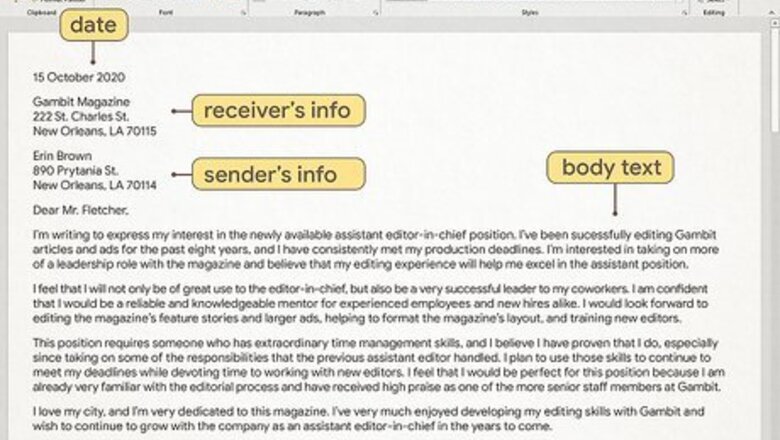
views
- Type your letter of request in a single-spaced legible font, like Times New Roman, and maintain an extra space between paragraphs.
- Introduce yourself in the first paragraph, and briefly address why you are writing.
- Describe your request more fully in the body of the letter, maintaining a respectful tone throughout. Be thorough but concise when you make your request.
- Close your letter by letting the recipient know when you need your request fulfilled by (if there is a deadline) and thanking them for their consideration. Sign off politely.
Writing a Draft
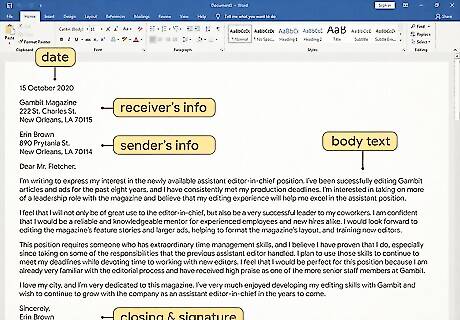
Format your letter like you would format a business letter. Writing your letter in the proper, professional format of a business letter will help you make a positive first impression. In the top left corner of your letter, state your full address, followed by the date, and then the full address of the recipient. Write your letter in a legible font, such as 12-point Times New Roman or Calibri, and single-space your letter, adding an extra space between paragraphs. You may also include a subject line after the recipient's address, but this is optional. Some people prefer to receive hard copies of your letter, but in some instances, sending your letter of request as an email may be acceptable. In this case, you won’t need to include the full address of the recipient, but still include your contact info.
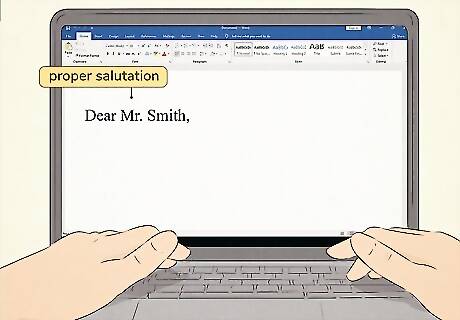
Start the letter with a salutation. Begin the main text of your letter with a proper, respectful greeting. Generally, letters of request begin with “Dear” or “To.” If you know the person you are writing to, you can use their first name, e.g. "Dear Tim." Otherwise, use the person's last name and the proper title, (eg. Dr., Mr., Ms. or Mrs.). If you don’t know the name of the person you are writing to, use a salutation like "Dear Sir or Madam," or "To Whom It May Concern."

Write an introductory paragraph. In the first paragraph of any letter of request, introduce yourself, and clearly but briefly state the purpose of the letter. For instance, you might say, "I am writing this letter in hopes that you will consider making a contribution to the Boston Citizen's Charity Fund." If you have had any previous interaction with the recipient of your letter, the opening paragraph is also a good place to remind them of the nature of your association or the contact you've had in the past. For example: "I am a student in your drama 101 class," "I'm the president of the Boston Citizens Charity Fund, an organization you've generously donated to for the last 10 years," or "I contacted you last month about the possibility of a class trip to your amusement park." Establishing a connection may promote feelings of affinity with you that might increase the chances of your request being granted.

Write a body paragraph. In your body paragraph (or paragraphs), provide additional context and information about what you’re asking for. Whereas in your intro you provided a basic overview of the purpose of your letter, the body is where you will get more detailed about what exactly you are requesting. This is your opportunity to spell out exactly what you're asking for and make your case for why your request should be granted. Be thorough but brief when asking for what you want. Clearly explain what it is you are requesting and why the matter is worthy of consideration, but don't share your life story. Leave the reader with no doubt as to what you want. For example: "I'm hoping you'll consider repeating your generous contribution this year," or "I'd like to respectfully request an opportunity to resubmit this paper." Be factual, but be courteous, and keep emotions in check. For instance, opt for "I was very disappointed when I saw my grade. I would appreciate the opportunity to retake the exam" over "I'm so mad about this grade and I want a do-over!"
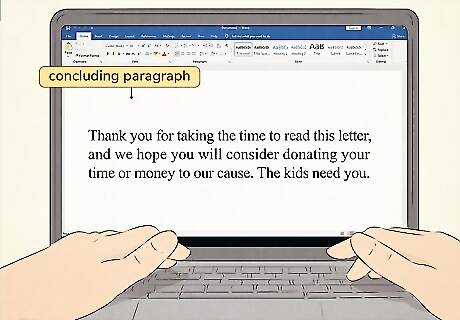
Write a concluding paragraph. In your concluding paragraph, make your recipient aware of any time constraints you face, if any. Be sure to also express your gratitude for their consideration of your request. For example, if you’re writing to request information or a meeting with someone that must occur before a certain date to be of any use to you, politely make that clear in the conclusion. Even if your recipient ultimately does not grant your request, the fact that they have taken the time to read your letter and consider your wishes is worthy of thanks.

Close the letter politely. Finally, your letter needs an appropriate and polite closing. Good options include "Respectfully," "Sincerely," or "Best regards," followed by your name. If you’re sending a physical letter, leave 4 lines of empty space between the closing and your typed name. In this space, sign your name with a pen. If you’re enclosing any materials with your letter, insert this information after your closing, e.g. "Enclosures: 2."
Finalizing the Letter

Set the letter aside for a few days before sending it. Rather than immediately sending your letter after finishing it, put it aside for a little while—a few days, if time permits. Then reread it and see if it needs any editing. The time away will give you a fresh perspective on it when you return to it. Try not to write your letter of request at the last minute. However, if you don’t have the time to let the letter incubate for a few days, enlist a friend to read it over for you before sending it off. They’re likely to catch errors you may have missed.

Edit and revise the letter. Give the letter a close reading to make sure your writing is clear, flows well, and accomplishes the goals you set out to accomplish. Make any necessary revisions. A good way to assess your writing is to read your letter out loud. This will help you to notice any missing words and generally get a sense of whether the language flows well and strikes the appropriate tone. Try reading your letter backwards. This will help you catch grammatical or spelling errors you may have skimmed over while reading straight through.

Proofread the final draft. After you've made your edits, give the letter one more look to catch any spelling and grammar mistakes that you might have missed the first time. Even if you’ve only made minor edits, proofread, proofread, proofread! Bad spelling and grammar can damage an otherwise well-written letter. It's a good idea to have someone else read your letter for this purpose as well. It’s much easier to overlook your own errors.

Send your letter. If you’re sending a physical letter, be sure to include a current and professional-looking stamp. In the top left of the envelope, put your name, title (if applicable), and return address. In the bottom middle, include the recipient's name and address. Make sure you keep a copy for your records until the matter is settled.
Preparing to Write

Brainstorm the big ideas. In order to write a clear, effective letter, it is crucial that you have a clear sense of your goals and the letter's purpose. Try journaling your thoughts, or talking it through with a friend or aloud to yourself. If you’re struggling to begin brainstorming, get 3 blank pieces of paper and label them "why I am writing this letter," "the purpose of this letter," and "other thoughts." Without worrying too much about details, take a few minutes and list your thoughts about the letter on these 3 pieces of paper.
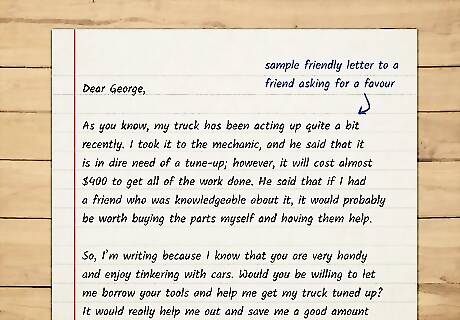
Consider your audience. Essential to setting the right tone in your letter is understanding the audience you’re writing for. After your initial brainstorm, on another piece of paper, write down what you know about the recipient of your letter. For example, what is this person's position, and how can they be of help? Will this person be making a final decision about your request, or making a decision about whether or not to pass your request on to a higher authority? It's also a good idea to consider the recipient's knowledge of the topic you’re writing about. If your reader is not well-versed in the topic you are writing about, this will necessitate a different type of writing (i.e., use of simpler language and the inclusion of more background information) than if your recipient is already an expert on the matter.
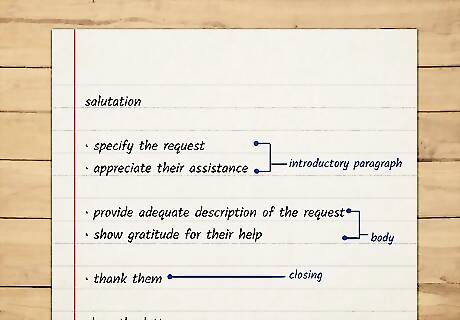
Make an outline. Finally, before you begin actually composing the letter, create an outline to organize your thoughts into a logical, coherent order. This will keep you from jumping around too much when drafting your letter, making it easier for your reader to follow what you’re saying. Consider the main points you want to make and the secondary points you’ll use to support those points. Make sure your ideas are organized in a way that will make sense to your reader.




















Comments
0 comment